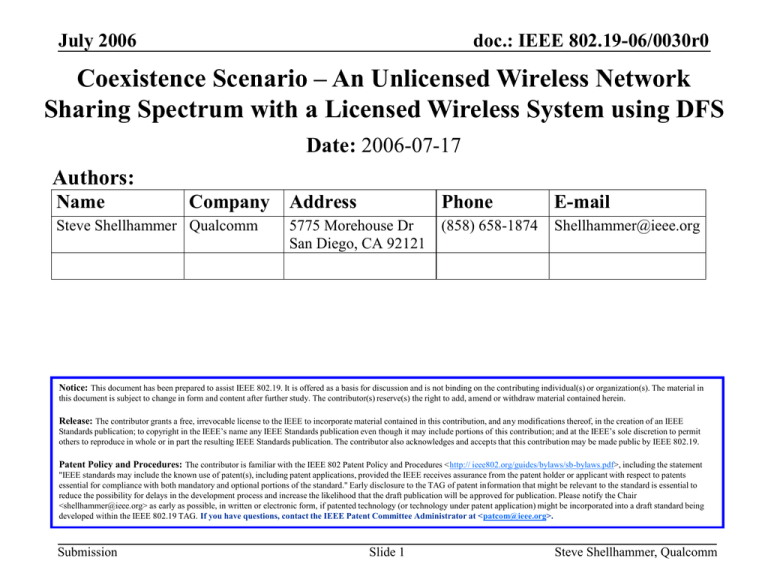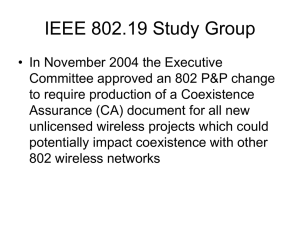Coexistence Scenario – An Unlicensed Wireless Network
advertisement

July 2006 doc.: IEEE 802.19-06/0030r0 Coexistence Scenario – An Unlicensed Wireless Network Sharing Spectrum with a Licensed Wireless System using DFS Date: 2006-07-17 Authors: Name Company Address Steve Shellhammer Qualcomm 5775 Morehouse Dr San Diego, CA 92121 Phone E-mail (858) 658-1874 Shellhammer@ieee.org Notice: This document has been prepared to assist IEEE 802.19. It is offered as a basis for discussion and is not binding on the contributing individual(s) or organization(s). The material in this document is subject to change in form and content after further study. The contributor(s) reserve(s) the right to add, amend or withdraw material contained herein. Release: The contributor grants a free, irrevocable license to the IEEE to incorporate material contained in this contribution, and any modifications thereof, in the creation of an IEEE Standards publication; to copyright in the IEEE’s name any IEEE Standards publication even though it may include portions of this contribution; and at the IEEE’s sole discretion to permit others to reproduce in whole or in part the resulting IEEE Standards publication. The contributor also acknowledges and accepts that this contribution may be made public by IEEE 802.19. Patent Policy and Procedures: The contributor is familiar with the IEEE 802 Patent Policy and Procedures <http:// ieee802.org/guides/bylaws/sb-bylaws.pdf>, including the statement "IEEE standards may include the known use of patent(s), including patent applications, provided the IEEE receives assurance from the patent holder or applicant with respect to patents essential for compliance with both mandatory and optional portions of the standard." Early disclosure to the TAG of patent information that might be relevant to the standard is essential to reduce the possibility for delays in the development process and increase the likelihood that the draft publication will be approved for publication. Please notify the Chair <shellhammer@ieee.org> as early as possible, in written or electronic form, if patented technology (or technology under patent application) might be incorporated into a draft standard being developed within the IEEE 802.19 TAG. If you have questions, contact the IEEE Patent Committee Administrator at <patcom@ieee.org>. Submission Slide 1 Steve Shellhammer, Qualcomm July 2006 doc.: IEEE 802.19-06/0030r0 Coexistence Scenario Description • Title – An Unlicensed Wireless Network sharing spectrum with a Licensed Wireless System using Dynamic Frequency Selection (DFS) • There are two cases in IEEE 802 that are use DFS – IEEE 802.11 sharing the 5 GHz frequency band with licensed radar systems – IEEE 802.22 sharing the TV broadcast bands with TV broadcasts and licensed wireless microphones Submission Slide 2 Steve Shellhammer, Qualcomm July 2006 doc.: IEEE 802.19-06/0030r0 Description • The unlicensed wireless network is permitted to operate in the frequency band as long as it does not cause harmful interference to the licensed wireless network • This is accomplished by monitoring the spectrum and if a licensed system is detected at a level that indicates the unlicensed wireless network would cause interference then the unlicensed wireless network switches to another channel Submission Slide 3 Steve Shellhammer, Qualcomm July 2006 doc.: IEEE 802.19-06/0030r0 Typical Geometry Unlicensed Operation Allowed Unlicensed Operation Disallowed Primary Transmitter Submission Slide 4 Steve Shellhammer, Qualcomm July 2006 doc.: IEEE 802.19-06/0030r0 Sensing Sensitivity Level • The geometry translates into a sensing sensitivity level in dBm • May include more detailed channel model – Multipath fading – Shadow fading Submission Slide 5 Steve Shellhammer, Qualcomm July 2006 doc.: IEEE 802.19-06/0030r0 Typical Coexistence Metrics • Sensing sensitivity level – The power level at which the primary signal can be reliably detected • Required sensing time • Probability of detection • Probability of false alarm Submission Slide 6 Steve Shellhammer, Qualcomm July 2006 doc.: IEEE 802.19-06/0030r0 Conclusion • Going forward this is likely to become a very important coexistence scenario • Many of the cognitive radio systems of the future will rely on effective dynamic frequency selection • Can leverage some of the work done in 802.11 and 802.22 to properly define this coexistence scenario Submission Slide 7 Steve Shellhammer, Qualcomm
